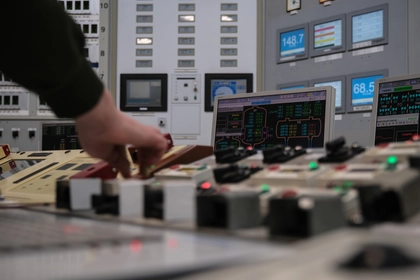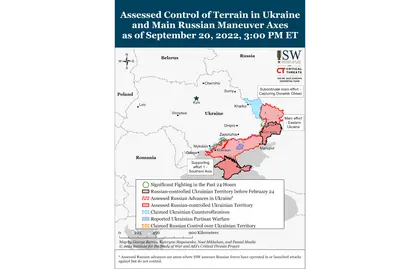Key Takeaways
- Russian-appointed occupation officials in Luhansk, Donetsk, Kherson, and Zaporizhia oblasts announced on September 20 that they will hold a “referendum” on acceding to Russia, with a vote taking place from September 23-27.
- The Kremlin’s annexation plans are primarily targeting a domestic audience; Putin likely intends to improve Russian force generation capabilities by calling on the Russian people to volunteer for a war ostensibly to defend newly-claimed Russian territory.
- Ukrainian forces continued disrupting ongoing Russian efforts to reestablish ground lines of communications (GLOCs) across the Dnipro River in Kherson Oblast.
- Russian forces are likely targeting Ukrainian hydrotechnical infrastructure in Kharkiv and Luhansk oblasts to threaten Ukrainian positions along the Siverskyi Donets River.
- Russian forces conducted ground attacks in Donetsk Oblast on September 20.
- Russian forces did not conduct any confirmed ground attacks west of Hulyaipole on September 20 and continued routine artillery strikes throughout Zaporizhia Oblast.
- Russian forces continue to degrade their force generation capabilities by cannibalizing training elements to fight in combat formations in Ukraine.
Russian-appointed occupation officials in Luhansk, Donetsk, Kherson, and Zaporizhia oblasts announced on September 20 that they will hold a “referendum” on acceding to Russia, with a vote taking place from September 23-27.[1] The Kremlin will use the falsified results of these sham referenda to illegally annex all Russian-occupied parts of Ukraine and is likely to declare unoccupied parts of Donetsk, Kherson, and Zaporizhia oblasts to be part of Russia as well.
JOIN US ON TELEGRAM
Follow our coverage of the war on the @Kyivpost_official.
The Kremlin’s annexation plans are primarily targeting a domestic audience; Putin likely hopes to improve Russian force generation capabilities by calling on the Russian people to volunteer for a war to “defend” newly claimed Russian territory. Putin and his advisors have apparently realized that current Russian forces are insufficient to conquer Ukraine and that efforts to build large forces quickly through voluntary mobilization are culminating short of the Russian military’s force requirements. Putin is therefore likely setting legal and informational conditions to improve Russian force generation without resorting to expanded conscription by changing the balance of carrots and sticks the Kremlin has been using to spur voluntary recruitment.
Putin may believe that he can appeal to Russian ethnonationalism and the defense of purportedly “Russian peoples” and claimed Russian land to generate additional volunteer forces. He may seek to rely on enhanced rhetoric in part because the Kremlin cannot afford the service incentives, like bonuses and employment benefits, that it has already promised Russian recruits.[2] But Putin is also adding new and harsher punishments in an effort to contain the risk of the collapse of Russian military units fighting in Ukraine and draft-dodging within Russia. The Kremlin rushed the passage of a new law through the State Duma on September 20, circumventing normal parliamentary procedures.[3] This law codifies dramatically increased penalties for desertion, refusing conscription orders, and insubordination. It also criminalizes voluntary surrender and makes surrender a crime punishable by ten years in prison. The law notably does not order full-scale mobilization or broader conscription or make any preparations for such activities.

Nuclear Power Plants Save Workers as Russian Bombings Intensify
ISW has observed no evidence that the Kremlin is imminently intending to change its conscription practices. The Kremlin’s new law is about strengthening the Kremlin’s coercive volunteerism, or what Chechen leader Ramzan Kadyrov called “self-mobilization.”[4]
The Kremlin is taking steps to directly increase force generation through continued voluntary self-mobilization and an expansion of its legal authority to deploy Russian conscripts already with the force to fight in Ukraine.
- Putin’s illegal annexation of occupied Ukrainian territory will broaden the domestic legal definition of “Russian” territory under Russian law, enabling the Russian military to legally and openly deploy conscripts already in the Russian military to fight in eastern and southern Ukraine. Russian leadership has already deployed undertrained conscripts to Ukraine in direct violation of Russian law and faced domestic backlash.[5] Russia’s semi-annual conscription cycle usually generates around 130,000 conscripts twice per year.[6] The next cycle runs from October 1 to December 31. Russian law generally requires that conscripts receive at least four months of training prior to deployment overseas, and Russian President Vladimir Putin has repeatedly denied that conscripts will be deployed to Ukraine.[7] Annexation could provide him a legal loophole allowing for the overt deployment of conscripts to fight.
- Russian-appointed occupation officials in Kherson and Zaporizhia oblasts announced the formation of “volunteer” units to fight with the Russian military against Ukraine.[8] Russian forces will likely coerce or physically force at least some Ukrainian men in occupied areas to fight in these units, as they have done in the territories of the Russian proxy Donetsk and Luhansk People’s Republics (DNR and LNR).
- The Russian State Duma separately passed new incentives for foreign nationals to fight in Russia’s military to obtain Russian citizenship and will likely increase overseas recruitment accordingly.[9] That new law, which deputies also rushed through normal procedures on September 20, allows foreign nationals to gain Russian citizenship by signing a contract and serving in the Russian military for one year. Russian law previously required three years of service to apply for citizenship.
- Putin’s appeals to nationalism may generate small increases in volunteer recruitment from within Russia and parts of occupied Donetsk and Luhansk. However, forces generated from such volunteers, if they manifest, will be small and poorly trained. Most eager and able-bodied Russian men and Ukrainian collaborators have likely already volunteered in one of the earlier recruitment phases.
- Local Russian administrators will continue to attempt to form volunteer units, with decreasing effect, as ISW has previously reported and mapped.[10]
- Russian forces and the Wagner Private Military Company are also directly recruiting from Russian prisons, as ISW has previously reported.[11] These troops will be undisciplined and unlikely to meaningfully increase Russian combat power.
Putin likely hopes that increasing self-mobilization, and cracking down on unwilling Russian forces, will enable him to take the rest of Donetsk and defend Russian-occupied parts of Luhansk, Kherson, and Zaporizhia oblasts. He is mistaken. Putin has neither the time nor the resources needed to generate effective combat power. But Putin will likely wait to see if these efforts are successful before either escalating further or blaming his loss on a scapegoat. His most likely scapegoat is Defense Minister Sergei Shoigu and the Russian Ministry of Defense. Reports that Shoigu would accompany Putin while Putin gave a speech announced and then postponed on September 20 suggest that Putin intended to make Shoigu the face of the current effort.[12]
Russian President Vladimir Putin likely also intends to deter Ukraine’s ongoing counteroffensives by annexing occupied Ukrainian territory and framing Ukrainian attempts to liberate occupied territory as attacks on Russia. Russian officials and propagandists such as Russian Security Council Deputy Chairman Dmitry Medvedev issued vague warnings on September 20 that “the infringement of Russian territory is a crime; committing this crime permits using all means of self-defense.”[13] Russian officials are demonstrably panicked over Ukrainian advances, as ISW assessed on September 19.[14] The Kremlin likely intends these vague warnings to exacerbate Ukrainian and global fears of nuclear escalation. However, Putin has already declined to enforce any territory-specific redlines in response to Ukrainian attacks on Russian-annexed Crimea, occupied territory he has controlled for eight years and declares to be Russian.
Ukrainian and Western leaders responded to reports of the impending referenda with renewed declarations of commitment to restoring Ukrainian sovereignty over occupied Ukrainian territory. Ukrainian Foreign Minister Dmytro Kuleba stated on September 20 that “sham ‘referendums’ will not change anything … Ukraine has every right to liberate its territories and will keep liberating them whatever Russia has to say.”[15] NATO Secretary-General Jens Stoltenberg said on September 20 that “[sham referendums] will only further worsen the situation, and therefore we need to provide more support to Ukraine.”[16] US National Security Advisor Jake Sullivan said on September 20 that the United States “will never recognize this territory as anything other than a part of Ukraine” and will continue to provide “historic support” to Ukraine.[17] German Chancellor Olaf Scholz emphasized on September 19 that “Ukraine has every right to defend the sovereignty and integrity of its own territory and its own democracy.”[18] French President Emmanuel Macron called the sham referenda a “parody” and a “provocation.”
Authors: Katherine Lawlor, Karolina Hird, George Barros, and Frederick W. Kagan
See the full report here.
You can also highlight the text and press Ctrl + Enter






